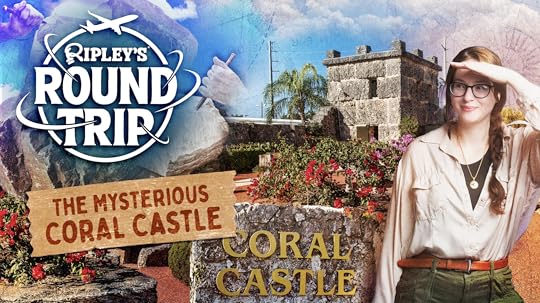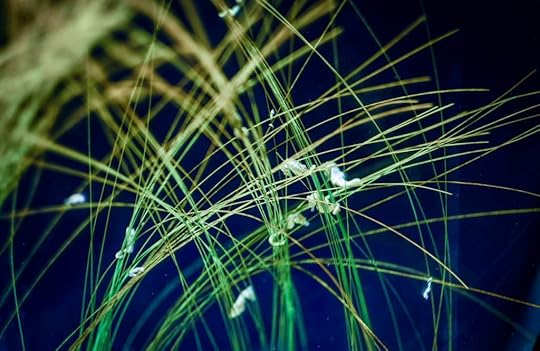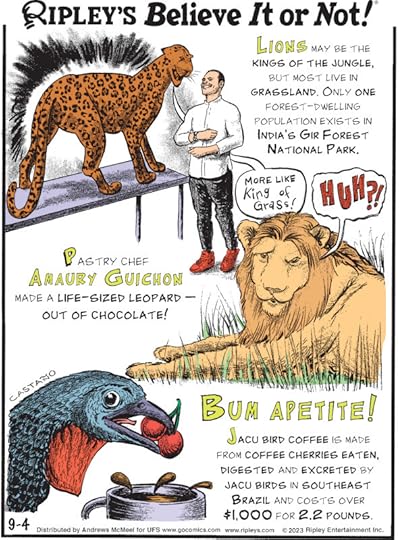Ripley Entertainment Inc.'s Blog, page 9
September 4, 2023
CARTOON 09-04-2023
September 3, 2023
CARTOON 09-03-2023
September 2, 2023
CARTOON 09-02-2023
September 1, 2023
Ripley’s Round Trip: The Mysterious Coral Castle
Featured in Ripley's Believe It or Not!

Today, on Ripley’s Round Trip, we’re taking you on a journey to the enchanting Coral Castle Museum in South Florida, an extraordinary stone sculpture garden built single-handedly by a man named Edward Leedskalnin. This bizarre destination is a must for your adventure list, so let’s dive in.
The Coral Castle ConstructionAt the age of 26, Edward became engaged to his one true love, Agnes Scuffs. Scuffs sadly canceled their wedding just one day before the ceremony, leaving Ed heartbroken. In an attempt to create a monument for his lost love, Ed began his lifelong quest to build the Coral Castle. Incredibly, Ed cut and moved over 1,100 tons of coral rock with only hand tools!
Despite being just over 5 feet tall and weighing around 100 pounds, he relied on his knowledge of weight and leverage. He also used his skills he acquired working in lumber camps and from his family of stonemasons in Latvia.

Edward Leedskalnin in Latvia, circa 1910. Credit: Wikimedia Commons.
How Coral is ThatThe Coral Castle in South Florida has been compared to the major mysteries and monumental accomplishments of the world. Comparisons include the pyramids in Egypt Stonehenge in England and the Taj Mahal in India. It’s believed that its creator Edward Leedskalnin was single-mindedly determined to build a monument to his lost love.

As you tour the Coral Castle, you’ll witness a 9-ton gate that moves with just a touch of a finger! You’ll also find a Polaris telescope, and functioning rocking chairs—all made entirely of stone. Believe It or Not!, Ed worked mostly at night by lantern light, ensuring his methods remained a mystery.
Coral Conspiracy?The theories surrounding Coral Castle include Ed’s supernatural powers and his claim of knowing the secrets used to build the ancient pyramids. Some believe that Ed’s monument was built simply as an homage to unrequited love. Others however, believe it was built to illustrate ancient sciences that defy gravity. Whatever the reason behind its construction, the Coral Castle stands as an everlasting mystery and serves as a testament to his incredible determination and devotion.
Well adventurers, we hope you enjoyed exploring the mysterious Coral Castle and learning about Edwards’ awe-inspiring achievement. If you enjoyed this episode, drop some destinations in the comments below! Who knows, it just may end up on a Ripley’s Round Trip. Until next time, happy adventuring!
EXPLORE THE ODD IN PERSON! Discover hundreds of strange and unusual artifacts and get hands-on with unbelievable interactives when you visit a Ripley’s Odditorium!The Largest Search For The Loch Ness Monster In 50 Years
Featured in Ripley's Believe It or Not!

A large gathering of monster hunters congregated in Scotland on August 26th and 27th in an attempt to find the elusive Loch Ness monster. The event, dubbed “The Loch Ness Quest,” organized by the Loch Ness Centre and a volunteer research team called Loch Ness Exploration, was “the biggest search of the Loch for more than 50 years.” An estimated 200 people participated in the two-day hunt, which included surveying equipment such as thermal drones, which had not previously been used while searching for Nessie in the past.
Searching the Loch NessThe drones incorporated infrared cameras to produce thermal images of the water based on heat signatures. The goal was to identify any “mysterious anomalies” in the loch. The team also used a hydrophone to detect acoustic signals in an effort to hear Nessie-like noises in the water.
Volunteers spaced themselves out around the 23-mile-long lake. Volunteers stood on the shore and others in boats to observe the lake’s surface and look for mysterious movements.
“We did hear something… four distinctive ‘gloops’,” search leader Alan McKenna told Reuters. “We all got a bit excited, ran to go make sure the recorder was on and it wasn’t plugged in.”
The Mystical MonsterThe folklore surrounding Nessie dates to the sixth century when Irish monk St. Columba allegedly sent a “water beast” into the River Ness. The famous, grainy black and white photo showing Nessie’s head and long neck protruding from the loch was taken in 1934, but six decades later the image was deemed a hoax involving a toy submarine. Still, many people believe Nessie was (and is) real. Over the years, numerous individuals and groups have tried to find evidence of its existence.

Irish monk St. Columba. Credit: Wikimedia Commons.
Volunteer Caroline McNamara has been intrigued by the Loch Ness monster since she was a child. She noted, “I chose the Loch Ness monster as my essay assignment, and I thought, ‘Oh 20 years later it comes full circle, so I might as well come and join the hunt’ since I heard it was happening.”
Unfortunately, the weather was not the most conducive for spotting movement on the water. It rained, and the waves were choppy. “The weather in Scotland was horrific over the weekend, so much so that the Scottish Highland Games were canceled for the first time in 75 years, but that didn’t stop us – and that didn’t stop our volunteers,” McKenna told Fox News.
People traveled from a variety of countries to participate in the hunt. Including Finland, France, Germany, Spain, and the United States.
Looking for More?Cryptozoology involves the study of cryptids—legendary, unknown, or extinct creatures such as Nessie as well as creatures including vampires, werewolves, and sea monsters and, of course, Bigfoot.
Earlier this month, a woman named Tina Kahlig from Texas observed a mysterious creature in her backyard. She posted a photo online, and people speculated that the animal could be the mystical Chupacabra.
If you would like to learn more about cryptids, check out this Ripley’s podcast, which includes an interview with a Skunk Ape expert. Find out whether there are laws protecting the captures of animals such as Nessie or Bigfoot.
By Noelle Talmon, contributor for Ripleys.com
EXPLORE THE ODD IN PERSON! Discover hundreds of strange and unusual artifacts and get hands-on with unbelievable interactives when you visit a Ripley’s Odditorium!Source: The Largest Search For The Loch Ness Monster In 50 Years
CARTOON 09-01-2023
August 31, 2023
5 Surprising Facts You Never Knew About Seahorses
Featured in Ripley's Believe It or Not!

Seahorses are whimsical-looking ocean creatures that are more than just interesting on the outside. These “horses of the sea” can range in size from under one inch to more than one foot long, and they reside in waters all over the world. Seahorses are adversely affected by climate change, plastic pollution, and other factors. Some ways to keep their populations strong is by combatting ocean trash, reducing your carbon footprint, and steering clear of single-use plastics.
Let’s dive into some surprising facts about these fascinating sea creatures!
1. They have difficulty swimming and move in unusual waysAlthough they are classified as fish, seahorses are not very good or fast swimmers. They are the slowest-moving fish in the sea due to the small size of the fin located on their backs, which is their only method of propulsion. Since this fin is so small, it hinders them from traveling long distances, and when the waves get rough in stormy weather, seahorses can die of exhaustion.
What makes these creatures special in the water is their ability to move forward, backward, up, and down. In addition, the shape of their heads enables them to swim quietly and stealthily. While seahorses may be slow swimmers, they use their bodies like a spring and neck bones like a crossbow to catch prey incredibly fast, according to Professor Roi Holzman of the School of Zoology at The George S. Wise Faculty of Life Sciences.
2. They are monogamous and dance for their matesWild seahorses tend to stay with their partners for a very long time, and some even mate for life! They live in areas with low density populations, have to camouflage themselves to avoid predators, and, as previously mentioned, are not the best swimmers. This means it can be challenging and risky to find a mate, according to the Smithsonian.
Bonding with a single partner allows them to go through several pregnancies each mating season, giving them a better chance of reproducing. Seahorses also go on “dates” each morning by performing ritualistic-looking dances, twisting and twirling their bodies in a variety of different ways to keep their mates engaged. These movements serve a variety of purposes: they strengthen their bond, demonstrate that their reproductive cycles are well matched, and confirm that they are committed to one another.
3. The male gets pregnant and gives birthSeahorse males incubate embryos in their tail pouches. According to the University of Sydney, the pouch contains a placenta and is comparable to a female mammal’s uterus. The fathers provide nutrients and oxygen to their unborn offspring, and they have some genetic similarities to mammalian pregnancies.

During labor, male seahorses bend their body towards their tails while pressing and then relaxing. The pouch briefly opens while the body jerks, allowing seawater to flush the pouch. Eventually, hundreds of seahorse babies are ejected. Baby seahorses are known as “fry,” and it is believed that less than 1 percent live to become reproducing adults.
4. They are excellent masters of disguiseSeahorses can change color and blend into their environment in order to avoid predators. They can change their appearances so quickly that it sometimes deters prey from attacking them.

Pygmy Seahorse (Hippocampus Bargibanti)
Seahorses use tiny, sack-like organs embedded in their skin called chromatophores to change color, according to Discover Wildlife. These chromatophores contain different pigments, and they expand and contract to produce different colors at different intensities. A seahorse’s nervous system activates the chromatophores to avoid predators.
5. They do not have stomachs and eat constantlySeahorses have different digestive systems compared to most marine species in that they do not have stomachs. As a result, the food that they eat and the way they feed is unique. Seahorses live in shallow and tropical waters around the globe and eat shrimp, krill, larvae, and algae, according to Outdoor Life Expert.
They do not need a stomach to store and digest these nutrients. Instead, their food disintegrates as soon as it enters the snout. The pancreas aids the intestines to break down the food. Seahorses need a lot of nutrition, so they eat constantly. In a single day, a baby seahorse can consume as much as 3,000 pieces of food!
Want to sea them in person?Don’t fret, the magic of the sea is right at your fingertips. Saddle up and see our beloved seahorses! Find a Ripley’s Aquarium near you and dive into adventure!
By Noelle Talmon, contributor for Ripleys.com
EXPLORE THE ODD IN PERSON! Discover hundreds of strange and unusual artifacts and get hands-on with unbelievable interactives when you visit a Ripley’s Odditorium!CARTOON 08-31-2023
August 30, 2023
CARTOON 08-30-2023
August 29, 2023
Octopus Moms Use Hot Tubs to Make Their Eggs Hatch Faster
Featured in Ripley's Believe It or Not!

Octopuses are some of the coolest and smartest critters in the ocean. Although they’ve been studied for years, cephalopod life cycles and behaviors continue to surprise researchers.
For example, a group of scientists recently came across an astounding find: thousands of octopuses huddled together near the base of an extinct underwater volcano. What were they doing? Taking advantage of a natural hot tub!
Octopus Hot Tubs Draw CrowdsThe hot tub-loving critters in question were all female pearl octopuses, and they numbered around 6,000. Besides species and gender, they had something else in common — clutches of eggs to protect. After further research, scientists came to a fascinating conclusion.
The eggs next to the extinct volcano hatched faster than those of their colder-water peers. Janet Voight of the Field Museum of Natural History in Chicago explains, “There are clear advantages of basically sitting in this natural hot tub.”
What do these advantages include? By hatching earlier, baby octopuses avoid many pre-hatch risks, like getting eaten by shrimp, snails, and various other predators. In fact, octopus moms who gather in the extinct volcano’s warmer water cut their egg-hatching times by more than half!
An Octopus’s Garden in the ShadeScientists have named the hot tub gathering of cephalopod moms an “octopus garden.” (Ringo Starr was onto something!)
They recorded some unique behaviors at the site. These behaviors included thousands of pearly octopuses, arms raised and transitioning between turning their eggs and pushing away potential predators.
How common are such octopus gardens? That’s a question researchers continue to ponder. Mike Vecchione of the Smithsonian National Museum of Natural History thinks they “may be widespread and really important in the deep sea, and we just previously knew very little about them. There’s still so much to discover in the deep sea.”
Cool Octopus FactsVecchione couldn’t be more correct — scientists still have much to learn about the ocean and creatures that call it home, like octopuses. But what we do know is extremely cool. Here are just a few of our favorite weird octopus facts!
Octopuses have three hearts! Two pump blood into the octopus’s gills, while the third circulates blood to its organs. Remarkably, this third heart automatically stops when the octopus swims. (Maybe that’s why they prefer crawling?)
Octopuses have blue blood! Oh, and the blood flowing through their veins? It’s blue, thanks to a pigment known as hemocyanin.
Octopuses are masters of camouflage! They can change their skin color and texture in a literal second. (Talk about giving chameleons a run for their money!)
Octopuses don’t have eight arms! They actually have six arms and two legs, all of which have literal minds of their own. About two-thirds of the neurons in an octopus’s body are found in their arms instead of their brains!
Octopus brains are shaped like donuts! The brain encircles the creature’s esophagus. This means, every time an octopus swallows, its food passes through its brain! Speaking of those brains, some scientists now believe octopuses can experience nightmares while sleeping.
Octopuses have built cities! “Octopolis,” the first known octopus city, was discovered in 2009, and others have been found since, like “Octlantis” off the coast of Eastern Australia. Octopuses living in these cities have complex social behaviors and will even evict unruly tenants!
Sea for Yourself!
Scientists have discovered ‘Octlantis’ pic.twitter.com/1xiTAQ4U7G
— Insider Business (@BusinessInsider) December 8, 2018
And that’s just scratching the surface when it comes to cool cephalopod facts! Want to learn more about some of the coolest octopuses on the planet or their other ocean companions? Swim over to one of our three amazing Ripley’s Aquarium locations to get up close and personal with these incredible creatures of the deep!
By Engrid Barnett, contributor for Ripleys.com
EXPLORE THE ODD IN PERSON! Discover hundreds of strange and unusual artifacts and get hands-on with unbelievable interactives when you visit a Ripley’s Odditorium!Source: Octopus Moms Use Hot Tubs to Make Their Eggs Hatch Faster
Ripley Entertainment Inc.'s Blog
- Ripley Entertainment Inc.'s profile
- 52 followers









